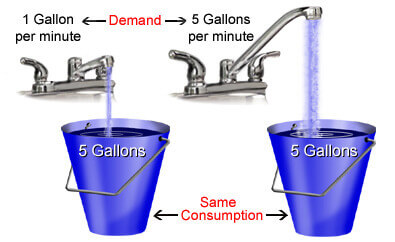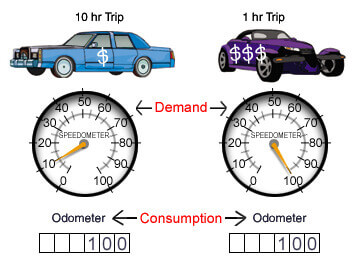You shopped for the lowest rate per kWh for your business. So what’s this other charge on your bill?
Business customers often pay a commercial electricity demand charge in addition to the cost per kWh. A demand charge is a fee based on the highest amount of power a customer draws during any 15 minute interval. Demand charges are established annually, and can add 30% or more to your electricity bill.
Read on to find out what is a demand charge, how demand charges are set, typical load factor by type of business and how your load factor impacts your demand.
Understanding Demand Charges
- What is a Demand Charge on an Electricity Bill?
- How Does Peak Demand Impact my Electricity Bill?
- Why Do Utilities Charge Demand Charges?
- Understanding Electricity Demand Charges
- How is My Peak Load Established: 4CP and PLC
- How Does Load Factor Impact My Electricity Bill?
- What is a Typical Load Factor for a Business?
- How Do I Calculate Electrical Demand or Power Load Factor?
- Formula to Calculate Load Factor for My Business
What is a Demand Charge on an Electricity Bill?
Most commercial customers have two charges on their bill driven by their electricity usage:
- Electricity Charges: This is the energy charge for the electricity you use (kWh) multiplied by your electricity price ($/kWh).
- Demand Charges: This is the energy charge for the amount of electrical capacity you need. It’s the maximum amount of kilowatts (kW) used during your highest usage during a 15 minute period within a given month. ($/kW).
Your electricity charges are the cost per kWh for electricity. That’s something you can shop for on ElectricityPlans.com.
Your demand charges come directly from your Transmission and Distribution Utility (TDU). You will usually see those demand charges as a direct pass through line item on your commercial electricity bill. You can’t avoid demand charges by switching providers. But you can control your demand charges.
Your demand charges are based on the maximum amount of electricity your business uses at a point in time, also known as your coincident peak demand.
You can think of it this way: when the electrical system grid was at it’s most stressed-out level, how much of the stress did your business cause?
How Does Peak Demand Impact my Electricity Bill?
Your peak demand impacts your electricity bill by (1) impacting demand charges on your bill (2) impacting your electricity rate.
Demand charges can make up 20-50% of a commercial customer’s bill, depending on your electricity usage pattern.
Your bill will typically show two demand numbers, even though you are only billed on one of them. One is your actual kW demand for the month. The other is your peak demand.
How is peak demand set? Your peak demand is set annually based on your usage in the 15 minute interval period when the overall grid had the highest demand. Once your peak demand is established, it will stay that way for 12 months … unless you reach a new peak. Because of this, you are typically billed based on the higher of the annual peak or your current month’s peak demand.
Oh. And here’s the other catch. Your peak demand is set each year based on the highest 4 usage intervals in the summer, called coincident peak demand days. And those peak demand days aren’t known until they actually happen. (More on that below.)
Having high demand / low load factor will also increase your cost per kWh from your electricity supplier.
An energy broker like ElectricityPlans.com can help you understand the items on your electricity bill, including demand charges.
Why Do Utilities Charge Demand Charges?
Utility companies charge for demand to offset the cost of having energy available to their customers at all times.
They need to ensure that power is always available when you flip the switch. When power usage is consistent, it’s easy for utilities to manage the transmission and distribution of power.
But utilities have to plan for the highest possible usage. They need to be “always ready” for when usage spikes. The cost of being “always ready” is the price of demand.
Understanding Electricity Demand Charges
Since this is a pretty complex topic, here are some examples to help understand electricity demand charges:
Water Flow. The more common analogy that explains electricity demand is water. Imagine that you have two buckets, and one is fine being filled with the standard water flow. But the other bucket wants to consume water faster, with a bigger pipe. The added cost to deliver that water is similar to demand.

Fast vs. Slow Car. Our last analogy for explaining demand uses a car. Any car can take you that 100 mile journey. But if you want to get there fast, you may want to pay more for the sports car. That’s your demand for speed… and you’ll pay for it in your vehicle and your gas consumption.

When you compare two businesses, they may use power very differently.
Business A and Business B use the same amount of power every month. Business A uses the same amount of power every day. Business B uses more electricity at certain times of the day, and almost nothing at other times of the day.
Business B is harder for the delivery company to manage. Because of that, they will have higher demand charges.
So now that we know what demand is, and why it’s charged, what determined the price you pay per kilowatt of demand? That’s your annual peak load measurement.
How is My Peak Load Established: 4CP and PLC
Your peak demand measurement and the demand rate tariff you pay ($/kW) is based on your Coincident Peak Demand.
Your Coincident Peak Demand is your actual demand on the days when the entire grid system hit its highest level of demand. That measurement then impacts your bill for the next calendar year.
Here’s the catch — no one knows when those days will be.
If you are in the PJM Market area (Illinois, Ohio, New Jersey, Pennsylvania and others) the Coincident Peak Demand is called the Peak Load Contribution (PLC). PJM looks back at the 5 overall highest peak hours of demand during the summer, from June to September. PJM assigns each customer a PLC of 0 to 100 based on their usage during those 5 hours, vs. the overall system usage. Accounts with a higher PLC have more impact on the grid, and will pay more.
In Texas (ERCOT market area) your peak demand charge is based on your peak usage during the Four Coincident Peaks, or 4CP. These are the 4 hours with the highest usage during each month of summer, June – September. (One hour per each month.)
Luckily for business owners, there are alerts that warn you of the opportunity for a coincident peak event.
- If you are a large commercial customer, you can subscribe to 4CP Alerts from your retail energy supplier or from the utility (if you are in a regulated market). Quant jocks monitor the weather, grid projections, supply and demand to predict when a system peak usage event will occur. They will give you advance warning so you can take high usage devices offline, or stagger your load.
- If you are a small commercial customer, monitor the web site for the local grid operator in your area (ERCOT, MISO, PJM). They will issue alerts for high usage days. These are also the days for a possible coincident peak event.
How Does Load Factor Impact My Electricity Bill?
Load factor isn’t something you see on your bill but it is the core behind the price you pay for electricity, and your demand charges. It is usually assigned to your meter as High Load Factor, Medium Load Factor or Low Load Factor.
Load factor compares average demand to peak (highest) demand.
- If you use power consistently (high load factor) you are a low demand customer. Your demand on the grid is low and your demand charges will be a smaller portion of your bill.
- If you use a lot of power over a short period of time (low load factor), you are a high demand customer. Your impact on the grid is higher. You will pay for that impact through your demand charges.
Your load factor will impact your electricity bill in two ways:
First, your load factor will impact your electricity price ($/kWh). Electricity providers prefer high load factor, low demand customers. These are the types of customers that use a consistent, predictable amount of power. Comparatively speaking, companies with high load factor are easier for electricity providers to buy and schedule power for.
Second, your load factor will impact your demand charges ($/KW). Your load factor may also impact the tariff class that your business is placed in (i.e. the rate you will pay per kW demand.)
What is a Typical Load Factor for a Business?
Load factors will vary by business, but below are average load factors by type of business:
| Industry Type | Average Load Factor | Electrical Load Factor Category | Electricity Demand Category |
|---|---|---|---|
| Education | 75-80% | High | Low |
| Grocery | 75-80% | High | Low |
| Health Care | 55-65% | Medium | Medium - Low |
| Retail Store | 50-60% | Medium | Medium |
| Hotel/Motel | 45-60% | Low | High |
| Restaurant | 50-55% | Low | High |
| Office | 45-55% | Low | High |
| Manufacturing | 35-50% | Low | High |
| House of Worship | 25-35% | Low | High |
- High Load Factor: If your load factor ratio is above 75% your electrical usage is reasonably efficient with a High Load.
- Medium Load Factor: If the load factor is below 50%, you have periods of very high usage (demand) and a low utilization rate with a Medium Load.
- Low Load Factor: Most small businesses are low load. If your load factor is below 40% you are low load factor. If you fit into this category, demand charges will have a significant impact on your monthly bill. You should take action to lower your demand charges.
On the ElectricityPlans.com site, you can shop for business electricity based on load factor. This feature is available for Texas business electricity. You can also shop based on start date, to view contract prices up to 6 months in the future.
TIP: Switching your retail energy supplier won’t change your load factor or your demand charges But you may be able to get a more competitive per kWh rate on your electricity. Shop online with ElectricityPlans.com to get the best business electricity rate.
How Do I Calculate Electrical Demand or Power Load Factor?
Load factor is the ratio of total energy (KWh) used in the billing period divided by the possible total energy used within the period, if used at the peak demand (KW) during the entire period.
Demand Load Factor = KWh/KW/hours in the period
You can calculate it by dividing average demand by peak demand for the billing period.
But since math is hard, and because you won’t find average demand on your bill, here are two examples of how to calculate load factor.
Formula to Calculate Load Factor for My Business
Here are two ways to calculate Load Factor. The first method assumes you just have one bill handy. The second method assumes you know your annual usage.
Method 1: Calculating Load Factor with Monthly Bill
For our sample business, we’ll take a look at a bill. The bill shows that they used 14,000 kWh during the month with a peak demand of 25 kW.
First we’ll calculate average demand for the month:
14,000 kWh / 720 hours in a month = 19.44 KW
Then, calculate the load factor by dividing average demand by peak demand:
19.44kW / 25kW = .77 or 77%
Or another way to calculate load factor using your monthly bill with the same information:
kWh usage = 14,000
kW = 25 kW
Number Days in Billing Cycle = 30
Number of Hours in a Day = 24
14,0000/ 25 * 30 * 24 =
14,000/18,000 = .77 or 77%
Method 2: Calculating Load Factor with Annual Usage
Using a full year of data is the preferred method for calculating load factor.
In this case, you don’t have to calculate average demand.
This method assumes that your peak demand is your consistent demand number throughout the year:
Annual Usage in kWh / (Peak Demand * 8760 hours in the year)
In the example business above:
168,000 kWh annual usage / (25kW * 8760 hours) = .77 or 77%
Additional Resources:
Hopefully this article has helped you better understand demand charges, load factor, coincident peak demand days, and how to lower your demand charges. These resources have additional information.
https://www.electronicshub.org/what-is-load-factor/
https://www.csu.org/CSUDocuments/hiddencostslowloadfactor.pdf
http://www.demandcharge.com/Web_Pages/Articles/Electrical_Load_Factor.html
